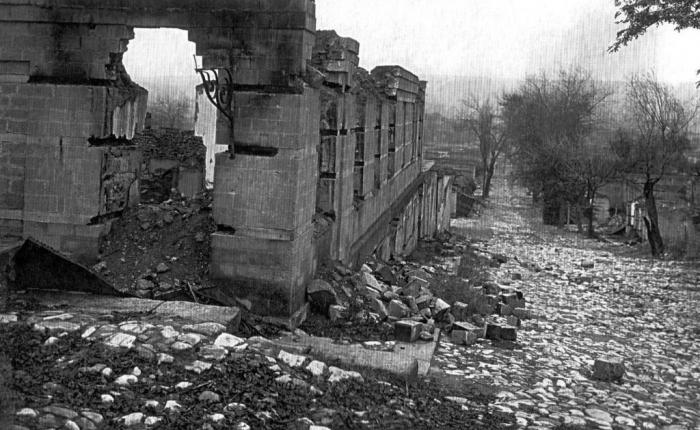The PROTOCOL of examination of Navagi village of Shemakha uyezd of the Baku province

On February 13th 1919, we, the members of the Extraordinary Investigation Commission of Azerbaijan Mikhaylov and Keyussovsky, examined the Navagi settlement to identify the scale and nature of its destruction by Armenian attacks, in present of the undersigned senior representative of Navagi settlement Aziz Bagir oglu. We found that:
The Navagi settlement is situated in a steppe, approximately 3 versts from the railroad station of the same name, and has only Moslem population. The settlement comprises of 2,000 household farms, which are scattered around in groups on both sides of the railroad at the distance of ?, ? versts from each other. The buildings have brickwork and flat pise roofs. The … part of the settlement looks like destroyed by fire even from a far distance. There are no estates which survived the fire and destruction, probably except several newly built houses. All others, a total of 2,000, were burnt down and represent ruins of burnt walls at present. Several houses in the settlements with richer population, are currently under reconstruction. These host several families of villagers, who survived the pogrom. Larger buildings, such as the mosque, school with 12 rooms, village government with … house, mills, all houses with stone foundation, … buildings, were strongly burnt down. Up to 80 shops, stores, storehouses with goods and warehouses were burnt in the village.
Large estates which did not only have 2-storey dwelling houses, but several household buildings, were also burnt. Such estates belong to Haji Shirali Haji Mursal oglu, Haji Movsum-Meshachli Yahya oglu, Haji Saftar Askerov, Haji Kelbali Huseyn Ali oglu, Mahmud Heydar oglu, Meshadi Samed bek Aleskerbekov, Kerbalayi Rustam Samed oglu, Haji Aga Mirza Kerbalai Abbas oglu, Meshadi Safar Ali Haji Pirim oglu, Faradjullabek Mirza-Bahish and Panah-han Ali oglu.
Fruit gardens in estates were cut or burnt. Nearly 300 large houses and buildings were burnt, total of … up to 2,000 buildings. Nearly 30 devices for pressing hay and stack were burnt. One may conclude from the foregoing that Navagi village was very large and rich, but it can be considered close to fully destroyed now. This is the protocol signed by the witnesses (attached are "21 acts on murders and 2 statements of special persons (pp. 24-27). One of the acts is attached further).
Witnesses (signed)
Senior village representative (signed)
Commission members (two signatures)
ACT
February 6th 1919.
I, the senior representative of Kubali Balaoglan of 217 houses, composed, together with selected honorary residents of our village, the following act: During Armenian attack upon our village in March of 1918, our residents suffered the following casualties:
1. Killed: 400 men, 290 women, 348 children
2. Injured: 40 men, 56 women, 40 children
3. 207 houses and buildings worth 300,000 roubles (300,000 deleted in original copy, the amount might be false) were destroyed.
4. 10 houses and buildings worth 285,000 roubles were burnt.
5. 10,000 heads of cattle worth 30,000,000 roubles stolen or killed.
6. 15,000 heads of small cattle and sheep stolen and killed.
7. Household equipment, agricultural equipment and grain worth 24,000,000 roubles stolen.
8. Grape and mulberry gardens worth 100,000 roubles damages.
9. Harvests of … and bread worth 1,000,000 roubles damages and stolen
10. Damages worth 1,000,000 roubles from the fields which remained unsown.
11. Damages total 8,978,500 roubles. [Similar acts were composed by senior representatives of the villages Padar, Taza Jegirli, nomad encampments Hila, Shorbachi, Pashali, Kovlar, Kazimi, Talysh, Meinimang, Abdulyan, Kolani-Turani, Kolani mount., Bozavend Ragimli, Ragim Agali, Karakashli, Ranchbar, Karakashli Arat, Navagi, Kuruzma].
Stamp
Senior village representative (signed)
Parish mullah (signed)
Aksakkals 7 signatures
Sources: CSAOR AzSSR, 1061, f.349, op. 1 ed. Stor.№57, pp 19-20
